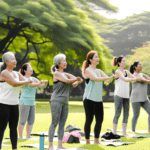Menopause and Muscle Mass
Menopause is a natural biological process that marks the end of a woman’s reproductive years. It is officially diagnosed after 12 consecutive months without a menstrual period and typically occurs between the ages of 45 and 55. Menopause is characterized by a decline in the production of the hormones estrogen and progesterone, which can have a wide-ranging impact on health. Symptoms such as hot flashes, night sweats, mood swings, and sleep disturbances are commonly reported. However, beyond these immediate symptoms, menopause can also lead to long-term health issues, including an increased risk of osteoporosis, cardiovascular disease, and metabolic syndrome.
The Importance of Muscle Mass for Longevity
Muscle mass plays a critical role in maintaining overall health and longevity. It contributes to metabolic health, physical strength, mobility, and balance, all of which are vital for an independent and active life as we age. Muscle tissue is also a significant determinant of basal metabolic rate, meaning that maintaining muscle mass can help prevent the weight gain often associated with aging. Furthermore, strong muscles are protective against falls and fractures, which are common and potentially serious problems for older adults.
Overview of Muscle Loss During Menopause
During menopause, women experience a decline in muscle mass, a condition known as sarcopenia. This loss of muscle is partly due to hormonal changes, particularly the decrease in estrogen, which has a protective effect on muscle tissue. Research findings suggest that postmenopausal women lose muscle mass at a rate of approximately 1-2% per year. This loss of muscle mass is associated with a decrease in muscle strength and function, which can significantly impact quality of life and increase the risk of disability. The exact mechanisms behind menopause-related muscle loss are complex and involve changes in hormone levels, protein synthesis, and muscle cell turnover. Understanding these changes is crucial for developing strategies to maintain muscle mass and strength during and after the menopause transition.
The Science Behind Muscle Loss in Menopausal Women
Research Findings on Muscle Mass Reduction
Studies have consistently shown that menopause is a critical period for muscle mass reduction in women. A notable 2021 study revealed that women in late perimenopause had 10 percent less muscle mass in their arms and legs compared to those in early perimenopause. This muscle loss is not just a cosmetic concern; it is closely linked to an increased risk of early mortality, making the preservation of muscle mass during menopause a significant health priority.
The Role of Hormonal Changes in Muscle Degradation
Hormonal fluctuations during menopause play a pivotal role in muscle degradation. The decline in estrogen and testosterone, hormones that are vital for muscle maintenance, is particularly impactful. Estrogen, for instance, is known to stimulate satellite cell proliferation and limit inflammatory stress damage on skeletal muscle. The loss of these hormones leads to a cascade of effects, including increased pro-inflammatory cytokines and a reduction in muscle estrogen receptors, which collectively contribute to muscle loss.
Comparing Muscle Mass in Different Menopause Stages
When comparing muscle mass across different stages of menopause, the contrast is stark. Cross-sectional studies have demonstrated that postmenopausal women have lower lean or muscle mass than their premenopausal counterparts. The aforementioned study also highlighted a significant drop in the appendicular lean mass index between early and late perimenopausal stages, emphasizing the vulnerability of the perimenopausal transition period for muscle loss.
Sarcopenia: Understanding Involuntary Muscle Loss
Sarcopenia, the involuntary loss of muscle mass and function, becomes a more pressing concern as women transition through menopause. This condition is not only associated with aging but is also exacerbated by menopausal hormonal changes. The prevalence of sarcopenia increases dramatically from early to late perimenopause, with late perimenopausal and postmenopausal women being significantly more likely to develop the condition. Understanding sarcopenia’s impact is crucial, as it is linked to increased risks of falls, fractures, and physical disability.
In conclusion, the science behind muscle loss in menopausal women is clear: hormonal changes significantly contribute to the reduction in muscle mass, with varying impacts across different stages of menopause. The transition period, especially perimenopause, is a critical window where interventions to preserve muscle mass could be most beneficial. Recognizing and addressing sarcopenia is essential for maintaining health and quality of life in menopausal women.

Popular Read: Why You Need to Swim in Cold Water during Menopause

From unhappy, dry, and sandpaper to silky, smooth and feeling good. That’s Cleo. Cleo is a 100% natural labial balm to moisture and soothe “your other lips”. Cleo is chemical-free, water-free, pH optimized and helps maintain and restore your delicate labial skin’s natural flora. Ideal for daily use or as needed. Get the most silky, lovable lips ever.
Health Benefits of Muscle Maintenance in Menopause
Cardiovascular Health and Muscle Mass
Maintaining muscle mass during menopause is not just about aesthetics or strength; it has profound implications for cardiovascular health. Studies have shown that women with higher muscle mass levels have a lower risk of dying from heart disease. This is particularly significant given that heart disease remains the leading cause of death for women. Muscle tissue plays a crucial role in metabolic health, aiding in blood sugar management and reducing the need for insulin, which can help maintain cardiovascular fitness and prevent heart disease.
Reducing Menopausal Symptoms with Muscle Strength
Menopause can bring about a host of uncomfortable symptoms, including hot flashes and night sweats. Research indicates that maintaining a higher level of lean body mass, which is essentially muscle, can protect against the development of these vasomotor symptoms. While building muscle may not completely eliminate hot flashes, it can potentially reduce their frequency and severity, which can significantly improve the quality of life for menopausal women.
Muscle Mass and Bone Density Correlation
The relationship between muscle mass and bone density is particularly important during menopause, a time when women are at increased risk for osteoporosis. Strength training, which builds muscle, also helps preserve bone health. This is critical because osteoporosis affects a significant number of women, with one in two women over the age of 50 likely to suffer a bone fracture due to low bone mineral density. By maintaining muscle mass through strength training, women can also help protect their bones.
Muscle Strength and Urinary Incontinence Prevention
Urinary incontinence is a common issue for menopausal women, and research has found a clear association between low muscle mass and strength and higher rates of urinary incontinence. Women with stronger thigh muscles, for example, have been shown to have a significantly lower incidence of urinary incontinence. This is likely because muscle loss in the limbs correlates with weakening of the pelvic floor muscles, which support the lower urinary tract.
Metabolic Health and Body Composition
As women age, particularly through menopause, the risk of developing metabolic syndrome and type 2 diabetes increases. Muscle mass is vital for metabolic health because it helps clear blood sugar from the bloodstream and maintains insulin sensitivity. By preserving muscle mass, menopausal women can better manage their body composition and reduce the risk of metabolic health issues, which often become more prevalent during this stage of life.
In conclusion, maintaining muscle mass during menopause is essential for a variety of health benefits, including cardiovascular health, symptom reduction, bone density, urinary incontinence prevention, and metabolic health. These benefits underscore the importance of strength training and proper nutrition as part of a comprehensive approach to health during menopause.
Strategies for Building and Maintaining Muscle
Effective Strength Training Techniques
For menopausal women, building and maintaining muscle mass is crucial, but it requires specific strategies to be effective. Research indicates that higher intensity lifting is beneficial for older adults. This includes 2 to 3 sets of multi-joint exercises per major muscle group at 70 to 85% of one repetition max (1 RM), 2 to 3 times a week. Additionally, incorporating power exercises performed at higher velocities with moderate intensities (40–60% of 1RM) can be advantageous. To maximize strength-building, women should work towards performing lifts like squats, bench presses, and deadlifts at heavy weights (4 to 5 sets of 6 or fewer reps at ~85% of 1 RM). Complementing these with exercises like lunges and rows at moderate intensity (3 sets of 8 reps at 75% 1RM) can round out a comprehensive strength training program.
The Role of Nutrition in Muscle Synthesis
Nutrition plays a pivotal role in muscle synthesis, particularly protein intake. Menopausal women may experience ‘anabolic resistance,’ meaning their muscles become less sensitive to protein. To combat this, increasing protein intake is essential. Research suggests that adults engaging in exercise should consume nearly twice the recommended dietary allowance (RDA) for protein (1.5 grams per kilogram of body weight) to maintain and augment muscle strength. For active women, the intake should be within the mid-to-upper ranges of current sport nutrition guidelines (1.4–2.2 g·kg·day).
Importance of Consistency and Progressive Overload
Consistency in exercise is key to building and maintaining muscle mass. Regular strength training, at least twice a week, is recommended by the World Health Organization for all adults. Progressive overload, gradually increasing the weight or resistance in exercises, ensures continuous muscle adaptation and growth. This principle should be applied consistently over time to achieve hypertrophy and improve body composition.
Addressing Common Barriers to Exercise
Common barriers to exercise include lack of time, motivation, or knowledge of proper techniques. To overcome these, setting realistic goals, scheduling regular workout times, and seeking guidance from fitness professionals can be helpful. Additionally, understanding the specific needs of menopausal women and tailoring exercise programs accordingly can enhance adherence and effectiveness.

Feeling You Have a Right to Safe Beauty & Fem Care?
If so, it may be time for a change. It starts with knowledge. We have a few suggestions in our new guides.
Dietary Considerations for Muscle Preservation
Protein Intake and Muscle Maintenance
Protein is the building block of muscle, and its intake is crucial for muscle maintenance, especially during menopause. Research indicates that menopausal women may require higher levels of protein than younger women to counteract the natural decline in muscle mass known as sarcopenia. A higher protein intake, distributed evenly throughout the day, can stimulate muscle protein synthesis and help maintain muscle mass. It is recommended that menopausal women aim for a protein intake of 1.2 to 1.5 grams per kilogram of body weight per day, with a focus on high-quality sources such as lean meats, fish, dairy, and plant-based proteins like legumes and soy.
Balancing Macronutrients for Optimal Health
While protein is essential for muscle preservation, a balanced intake of all macronutrients is important for overall health. Carbohydrates provide the energy needed for exercise and daily activities, while fats, particularly omega-3 fatty acids, support hormonal balance and reduce inflammation. Menopausal women should aim for a diet that includes a balance of complex carbohydrates, healthy fats, and lean proteins, with an emphasis on whole foods over processed options. This balance helps not only in maintaining muscle mass but also in managing body weight and metabolic health.
Nutritional Timing Around Exercise
The timing of nutrient intake can enhance the muscle-preserving effects of exercise. Consuming protein-rich foods or supplements within 30 minutes after strength training can maximize muscle repair and growth. This post-exercise window is when muscles are most receptive to the amino acids needed for recovery. Additionally, including a moderate amount of carbohydrates in the post-exercise meal can replenish glycogen stores and improve recovery. Pre-exercise nutrition is also important, with a focus on easily digestible foods that provide sustained energy without gastrointestinal discomfort.
In conclusion, menopausal women can benefit greatly from dietary strategies that support muscle preservation. By ensuring adequate protein intake, balancing macronutrients, and timing nutrition around exercise, the detrimental effects of menopause on muscle mass can be mitigated, leading to improved health and quality of life.
By the way, something for you, a little gift!!!
I am just in the middle of publishing my book. It’s about How women can balance their hormones. One part is about food and diet, of course.
Follow this link and enter your email.
I will send you this part of the book for free once the book is published. It has many concrete, practical tips and recipes and will help you feel better during menopause or times of Big hormonal fluctuations.
Annette, Damiva Lead for Health & Wellness

Lifestyle Factors Influencing Muscle Health in Menopause
Sleep Quality and Muscle Recovery
Quality sleep is essential for overall health and plays a critical role in muscle recovery. During sleep, the body undergoes various anabolic processes that repair and build muscle tissue. Menopausal women often experience sleep disturbances due to hormonal fluctuations, hot flashes, and night sweats, which can impede the muscle recovery process. Ensuring adequate sleep hygiene, such as maintaining a regular sleep schedule, creating a comfortable sleep environment, and avoiding stimulants before bedtime, can help improve sleep quality and, consequently, muscle health.
Stress Management and Hormonal Balance
Chronic stress can lead to elevated cortisol levels, which may contribute to muscle degradation and hinder muscle-building efforts. Menopausal women are particularly susceptible to stress due to the significant life changes and hormonal shifts they experience. Stress management techniques such as mindfulness, meditation, and deep breathing exercises can help maintain hormonal balance and support muscle health. Additionally, engaging in regular physical activity can act as a natural stress reliever and promote muscle strength and endurance.
The Impact of Alcohol and Smoking on Muscle Health
Alcohol consumption and smoking have detrimental effects on muscle health. Alcohol can interfere with protein synthesis, a key process in muscle repair and growth, while smoking impairs blood flow and reduces the oxygen supply to muscles, which is vital for muscle function and recovery. Menopausal women should be particularly mindful of their alcohol intake and smoking habits, as these can exacerbate muscle loss associated with aging and hormonal changes. Lifestyle modifications to reduce or eliminate alcohol and smoking can significantly benefit muscle preservation and overall health during menopause.
In conclusion, menopausal women can support their muscle health by prioritizing sleep, managing stress, and avoiding harmful substances like alcohol and tobacco. These lifestyle factors, in conjunction with a balanced diet and regular exercise, can help mitigate the muscle loss commonly seen during this life stage.
Embracing Strength Training for a Healthier Menopause
Summarizing the Benefits of Muscle Maintenance
Throughout this article, we’ve explored the critical role that muscle maintenance plays in the health and well-being of menopausal women. Strength training emerges as a beacon of hope, offering a multitude of benefits that extend far beyond the gym. By engaging in regular resistance exercises, women can combat the natural decline in muscle mass and bone density associated with hormonal changes during menopause. This proactive approach not only enhances metabolic health and body composition but also contributes to the prevention of sarcopenia, cardiovascular diseases, and urinary incontinence. Moreover, the empowerment gained through increased physical strength can lead to a reduction in menopausal symptoms, fostering a sense of control and resilience during this transformative phase of life.
Encouragement for Starting a Strength Training Routine
For those who may feel daunted by the prospect of starting a strength training routine, let this be your gentle nudge towards a healthier, more vibrant menopause. The journey to muscle maintenance need not be overwhelming; it can start with simple, manageable steps. Embrace the process as an evolving motivation, a chance to reshape your identity and view yourself as someone who exercises. The support and guidance of professionals, such as physiotherapists, can provide the necessary push to exceed your own expectations. Remember, the act of starting is often the most challenging part, but once you begin, the benefits you reap will fuel your continued commitment to this life-enhancing practice.
Final Thoughts on Longevity and Quality of Life
In conclusion, strength training is not merely a strategy to counteract the physical effects of menopause; it is an investment in your longevity and quality of life. The discipline and consistency required to maintain muscle mass during menopause are rewarded with a stronger, more capable body and a fortified spirit. As you embark on or continue your strength training journey, do so with the knowledge that each session contributes to a symphony of health that will resonate through the years. Embrace the empowerment that comes with strength training, and let it be the soundtrack to a healthier, more harmonious menopause. With each lift, press, and curl, you are composing a future of vitality, strength, and well-being. So, take up the baton, conduct your body’s orchestra with confidence, and thrive through menopause with the power of muscle maintenance.











